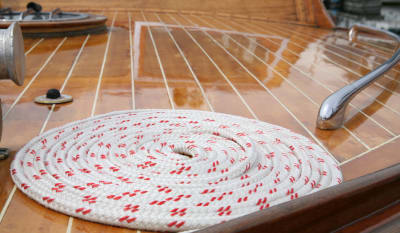Varnishing Tips and Tricks
 How do I Varnish?
How do I Varnish?
Everyone loves the look of perfect brightwork on a boat – that beautiful mirror like finish with the warm glow of the teak shining through. But if you've ever owned a boat, you also know the pain of watching that varnish peel off or break down under the harsh effects of the outdoors. Following, we help you navigate the basics of varnishing to keep your boat looking its very best.
If you haven't done much varnishing, it helps to conceptualize the process as occurring in three phases:
- Stripping – removing previous varnish, paint, or other coatings
- Preparation – sanding and cleaning the surface to be varnished
- Finishing – applying the varnish
A good varnish job greatly depends on the preparation, so plan on spending the majority of your time in the stripping and preparation phases. Every imperfection in your prep job will be amplified by the varnish – so take your time getting everything right before you start varnishing.
Stripping
| Products You'll Need During Stripping: | |
| Heat Gun | Chemical Stripper |
| Scrapers | Solvent Resistant Masking Tape |
| Lacquer Thinner | Disposable Paint Brushes (application of chemicals) |
| Gloves | Nylon Scrub Brushes (for removal of stripper) |
| Safety Glasses | Chemical Respirator (if using chemicals) |
Stripping the wood can be done in a variety of ways. If the current varnish is in pretty bad shape, it's probably best to take all of it off and start from scratch. One approach is to use a chemical stripper which you paint on to dissolve the existing varnish. Another approach is to use a heat gun and a scraper, gently scraping away the varnish, while being very careful to not dig into the wood below. The third option is to just sand away all of the old varnish until you have a nice smooth finish. Each method has its own benefits, so you'll have to experiment to decide what works best for you.
For badly stained teak, you may need to use a specific teak cleaning and/or bleaching product. Fisheries Supply carries quite a few options such as Teka or Teak Wonder.
Preparation
| Products You'll Need During Preparation: | |
| Various Grits Sandpaper | Various Grits Sanding Sponges |
| Scotchbrite Pads - Green | Safe Release Masking Tape |
| Dust Mask | Denatured Alcohol |
| Cotton Rags | Tack Cloths |
Once you've removed the prior surface, it's time for the preparation phase. This is where you want to get your wood perfectly sanded so it's silky smooth to touch. This can take a very long time, but your patience here will really pay off. Start with lower grit sandpaper (as coarse as you need to remove any dings or scratches), working up to 220 grit for proper smoothness, then finish with 320 grit or a green Scotch-Brite pad for that silky texture if you're after a mirror like finish.
Once everything has been properly sanded, it's imperative that you remove all the sanding dust. First, remove any tape you've used for masking, then vacuum all surfaces thoroughly. Follow by wiping down the surface with denatured alcohol and a white cotton rag, making sure to change out your rag as it gets full of dust. Wipe every surface to be varnished until you are no longer seeing dust collect on your rag. Finally, wipe each surface one more time with a tack cloth – a slightly sticky cloth that picks up the last of the dust and dirt.
Finishing
| Products You'll Need During Finishing: | |
| Varnish | Companion Thinners/Reducers |
| Latex Gloves | Safe Release Masking Tapes |
| Containers & Lids | Paint Strainers |
| Tack Cloths | Foam Brushes - Assorted Sizes |
| Cotton Rags | Bristle Brushes - Assorted Sizes |
| Knee Pads | Single Edged Razor Blades |
One of the most important factors when varnishing is the weather. Make sure you pick a day that will be warm, dry and not overly hot. The best temperature for varnish application is between 70° to 85° Fahrenheit, without too much humidity. If it's under 65°, your varnish could take days to dry. If it's over 85°, you risk the that the solvents in the varnish will evaporate too quickly, which makes it set up too fast, causing brush marks and bubbles. If you absolutely have to work in higher temperatures, thin the varnish (up to 25%) and work in smaller sections. If it's too humid – you're varnish may fog before drying – not pretty! Choose your weather wisely or all that preparation will be for nothing and you'll be back to square one.
Tape everything off once more to protect the areas around your wood. For your first coat, which will act as a sealant, strain the varnish into your container and then add the recommended thinner (read the can) by up to 50%. Since this is sealing the wood, you want to ensure that the varnish gets into every nook and cranny - so that's why you thin more than you normally would. Apply your first coat by quickly painting across the grain, and then finish brushing WITH the grain of the wood. If your wood is highly porous, you may want to apply a second sealant coat.
Make sure you let this coat (and every coat after it!) dry completely. This is one of the most important parts of vanishing and the one that is the easiest to screw up when we start getting impatient. Apply the next coats of varnish, building it up slowly and sanding lightly between coats as needed to keep your surface smooth. Do not try to sand before the varnish is completely dry! How can you tell? When sanding, the varnish should come off like a powder – if it's clogging up your sandpaper you've jumped the gun and need to wait longer. Once you're sure it's dry, sand off just enough to take away the shine and create a perfectly smooth surface – you should easily be able to see drips or where your varnish has become uneven and needs extra work. Make sure you do a full vacuum/alcohol and tack wipe after every sanding as dust is the enemy! 320 grit sandpaper and the green Scotch-Brite pads are your best tools here. Depending on the surface, you may need anywhere from 5 to 10 coats of varnish – it's really up to you and whether you're just protecting the wood, or are seeking that mirror-like gloss finish. Just remember - the more coats you have, the longer you will have before this job needs to be redone!
Most importantly – don't rush – a good varnish job is a labor of love. Take your time and enjoy the process!
Additional tips:
- For large surfaces, consider using a small foam roller to get faster, more even coverage – then follow with a bristle brush to lightly tip the varnish out, removing any bubbles created by the roller.
- Do not apply varnish thickly! Use a light hand and spread in a thin, even coat. Thick varnish tends to bubble and slide – creating dribs and drabs that you'll have to sand off later - which can take a long time. Thick coats also take much longer to dry and often dry unevenly – creating much more work in the long run when you have to sand it off.
- When loading your brush, load only the first ¼” or so and dab it against the side of the bucket to remove excess varnish. Then dab the varnish across the surface of your wood before spreading it out evenly. This helps you apply an even coat, instead of releasing all the varnish with the first stroke.
- When opening your can of varnish, lightly mix it – feeling for sediment in the bottom. It's important not to mix too vigorously as that will introduce bubbles into the varnish. You should always strain your varnish before application – strainers are cheap and it's quick to do, so don't skip this step!
- When tipping to remove air bubbles, move quickly across the surface. If the surface has already gone tacky, it's too late to tip – work in smaller areas to make sure you can finish tipping before the varnish has dried too much.
- When you remove your tape at the end, you will likely have some spots where the varnish has overrun the tape onto the fiberglass. Simply use a razor blade to carefully scrape it off – running level with the surface – don't dig in!
- Wear gloves! It's much easier to take off a glove than to try to get varnish off your skin with toxic chemicals.
- Varnish experts will argue forever on what is the best brush to use – but for beginners it's usually best to start with a foam brush – and switch them out when they get too saturated. Buy a handful of each size – they're cheap!
- Most importantly – don't rush – a good varnish job is a labor of love. Take your time and enjoy the process!
We hope you've enjoyed this guide to varnishing – but if you have any further questions, please don't hesitate to contact our paint experts at (800) 426-6930.
